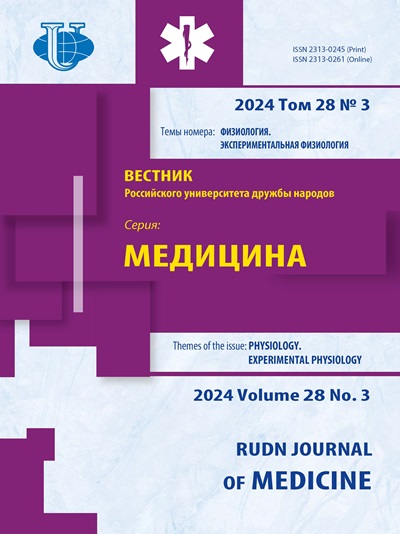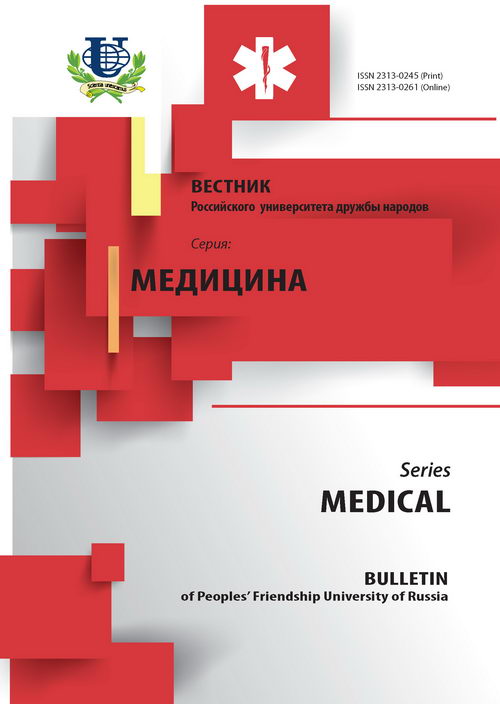Эпигенетика и эпигенетические абберации при миоме матки
- Авторы: Есенеева Ф.М.1, Киселев В.И.2, Салимова Л.Я.3
-
Учреждения:
- Российский университет дружбы народов
- ФГБУ «Российский научный центр рентгенорадиологии»
- Городская клиническая больница им. В.М. Буянова
- Выпуск: № 2 (2016)
- Страницы: 160-170
- Раздел: Статьи
- URL: https://journals.rudn.ru/medicine/article/view/3345
Цитировать
Полный текст
Аннотация
В статье приведен краткий обзор основных современных направлений патогенеза миомы матки, отдельно выделена эпигенетика как самостоятельная наука, изложены наиболее изученные эпигенетические механизмы, произведена попытка оценить роль эпигенетики в патогенезе миомы матки, а также рассмотрены возможные перспективы изучения эпигенетических механизмов и применения в практике.
Об авторах
Фарида Мухарбиевна Есенеева
Российский университет дружбы народов
Email: eseneeva85@bk.ru
Всеволод Иванович Киселев
ФГБУ «Российский научный центр рентгенорадиологии»
Email: vkis10@mail.ru
Лейла Яшаровна Салимова
Городская клиническая больница им. В.М. Буянова
Email: leilasal@mail.ru
Список литературы
- Asada H., Yamagata Y., Taketani T. et al. Potential link between estrogen receptor-alpha gene hypomethylation and uterine fibroid formation. Mol. Hum. Reprod. 2008. Vol. 14. Iss. 9. P. 539-545.
- Cardozo E.R., Clark A.D. et al. The estimated annual cost of uterine leiomyomata in the United States of America. Obstetrics & Gynecology. 2012. P. 211.e1-211.e9.
- Carey N. The epigenetics revolution. How modern biology is rewriting our understanding of genetics, disease and inheritance. N. Carey. Phenix. 2012. Р. 349.
- Coddington C.C., Grow D.R., Ahmed M.S. et al. Gonadotropin-releasing hormone agonist pretreatment did not decrease postoperative adhesion formation after abdominal myomectomy in a randomized control trial. Fertility and Sterility. 2009. Vol. 91. Iss. 5. P. 1909-1913.
- Fujimota J., Hirose R., Ichigo S. et al. Expression of progesterone receptor form A and B mRNAs in uterine leiomyoma. Tumor Biology. 1998. Vol. 19. No. 2. P. 126-131.
- Gross K.L., Morton C.C. Genetics and the development of fibroids. Clinical Obstetrics and Gynecology. 2001. Vol. 44. P. 335-349.
- Guo X., Wang X.F. A mediator lost in the war on cancer. Cell. 2012. P. 927-929.
- Jichan N., Liu Xishi, Guo S.W. Promoter hypermethylation of progesterone receptor isoform B (PR-B) in adenomyosis and its rectification by a histonedeacetylase inhibitor and a demethylation agent. Reproductive Science. 2010. Vol. 17. Iss. 11. P. 995-1005.
- Kawakami T., Zhang C., Taniguchi T. et al. Characterization of loss-of-inactive X in Klinefelter syndrome and female-derived cancer cells. Oncogene. 2004. P. 6163-6169.
- Kim S., Xu X., Hecht A., Boyer T.G. Mediator is a transducer of Wnt/beta-catenin signaling. Biology and Chemistry. 2006. Vol. 281. P. 14066-14075.
- Kurachi O., Matsuo H., Samoto T. et al. Tumor necrosis factor- expression in human uterine leiomyoma and its down-regulation by progesterone. Journal of Clinical Endocrinology and Metabolism. 2001. Vol. 86. No. P. 2275-2280.
- Lian Li, Lee Kyoung-Mu, Han Wonshik et al. Estrogen and progesterone receptor status affect genome-wide DNA methylation profile in breast cancer. Human Molecular Genetics. 2010. Vol. 19. Iss. 2. P. 4273-4277.
- Luo X., Yin P., Reierstad S. et al. Progesterone and mifepristone regulate L-type amino acid transporter 2 and 4F2 heavy chain expression in uterine leiomyoma cells. J. Clin. Endocrinol. Metab. 2009. Vol. 94. Iss. 11. P. 4533-4539.
- Maekawa R., Sato Shun et al. Genome-Wide DNA Methylation Analysis Reveals a Potential Mechanism for the Pathogenesis and Development of Uterine Leiomyomas. PLOS. 2013. P. 1-13.
- Maruo T., Matsuo H., Samoto T. et al. Effects of progesterone on uterine leiomyoma growth and apoptosis. Steroids. 2000. P. 585-592.
- Masanori O., Yin Ping, Navarro Antonia et al. Inhibition of canonical WNT signaling attenuates human leiomyoma cell growth. Fertility and Sterility. 2014. Vol. 101. No. 5. P. 1441-1449.
- Markowski D., Helmke B.M., Belge G. et al. HMGA2 and p14Arf: major roles in cellular senescence of fibroids and therapeutic implications. Anticancer Research. 2011. Vol. 31. No. 3. P. 753-761.
- Mehine M. et al. Genomics of uterine leiomyomas: insights from high-throughput sequencing. Fertil. Steril. 2014. Vol. 5.
- Morelli C., Garofalo C., Bartucci M. et al. Estrogen receptor-alpha regulates the degradation of insulin receptor substrates 1 and 2 in breast cancer cells. Oncogene. 2003. P. 4007-4016.
- Radzinsky V.E., Totchiev G.F. Мyoma: course on organsaving treatment. Informational bulletin. Status Praesens. 2014. P. 24.
- Shun, S. Potential mechanisms of aberrant DNA hypomethylation on the x chromosome in uterine leiomyoma / Shun Sato, Ryo Maekawa et al. // Journal of Reproduction and Development. 2014. Vol. 60. No. 1. P. 47-54.
- Tseng Y.H., Butte A.J., Kokkotou E. et al. Prediction of preadipocyte differentiation by gene expression reveals role of insulin receptor substrates and necdin. National Cell Biology. 2005. P. 601-611.
- Qiwei Y., Aymara Mas, P. Michael Diamond et al. The Mechanism and Function of Epigenetics in Uterine Leiomyoma Development. Reproductive Sciences. 2015. P. 1-13.
- Yamagata Y., Maekawa R., Asada H. et al. Aberrant DNA methylation status in human uterine leiomyoma. Molecular Human Reproduction. 2009. P. 259-267.
- Ying Z., Weiyuan Z. Dual actions of progesterone on uterine leiomyoma correlate with the ratio of progesterone receptor A: B. Gynecological Endocrinology. 2009. Vol. 25. No. 8. P. 520-523.
















